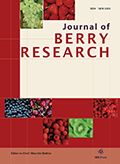Authors: Cocco, Carine | Magnani, Sabina | Maltoni, Maria Luigia | Quacquarelli, Irene | Cacchi, Mattia | Antunes, Luis Eduardo Corrêa | D’Antuono, Luigi Filippo | Faedi, Walther | Baruzzi, Gianluca
Article Type:
Research Article
Abstract:
Site effects on the main active and putative health-promoting compounds of strawberry were investigated using 5 strawberry genotypes. The plants were grown at three locations in Italy (Verona and Cesena in the North and Scanzano Jonico in the South) of differing latitude, environmental conditions (temperature) and crop management practices (planting date, plant type, harvest duration, yield per plant and per day) influencing fruits quality traits. At each site, fruits for analysis were picked at mid harvest (50% of total estimated yield) during the peak April-May marketing season, a mid-harvest window when consumers can choose fruits from both northern and southern
…districts. Yield per plant and fruits total soluble solids, titratable acidity, flesh firmness, skin colour, antioxidant activity, ascorbic acid, total phenols, total anthocyanins and phenolic compounds were determined. Genotype × site × climatic factors and cultivation technique interaction significantly affected yield per plant and almost all fruits quality traits. Given the longer harvest period and, hence, lower yield per day in the South, the fruits of this site were sweeter and of higher ascorbic acid and anthocyanin contents than that grown at the two North sites; the Verona fruits registered the highest acidity and antioxidant capacity. Fruits size and colour were unaffected by site. Soluble solids and ascorbic acid were negatively correlated to plant yield per day. A significant negative correlation between total antioxidant capacity, total polyphenols and fruits size was found. The main anthocyanin (pelargonidin-3-glucoside) was correlated to both total anthocyanin and total antioxidant capacity. Our overall data show that site-specific environmental conditions, especially in regard to the length of the climate-induced harvest window, and crop management practices affected fruits quality traits.
Show more
Keywords: Antioxidant capacity, genotype × environment × cultivation interaction, F.× ananassa, sensory traits
DOI: 10.3233/JBR-150098
Citation: Journal of Berry Research,
vol. 5, no. 3, pp. 145-155, 2015





